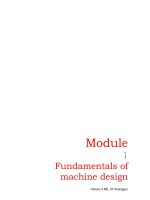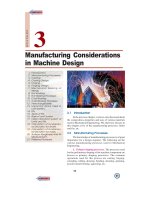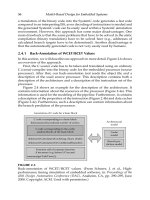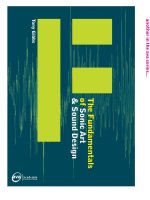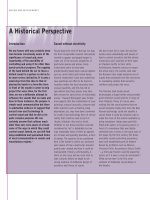Sonic Art & Sound Design- P3 pptx
Bạn đang xem bản rút gọn của tài liệu. Xem và tải ngay bản đầy đủ của tài liệu tại đây (675.65 KB, 5 trang )
p10
Job no : 76098 Title : The Fundamentals Of Sonic Art Client : AVA
Scn :
#
150 Size : 200(w)230(h)mm Co : M11 C0 (All To Spot)(Coagl)
Dept : DTP D/O : 16.02.07 (Job no:76098C1 D/O : 09.03.07 Co: CM11)
QC Preflight Point
1
st
00
76098_CTP_001-011.qxd 3/24/07 5:36 AM Page 10
p10
1
st
76098_CTP_001-011.qxd 3/24/07 5:36 AM Page 10
p10
1
st
76098_CTP_001-011.qxd 3/24/07 5:36 AM Page 10
THE FUNDAMENTALS OF SONIC ART & SOUND DESIGN
p10
‘THERE IS NO SUCH THING AS AN EMPTY
SPACE OR AN EMPTY TIME. THERE IS
ALWAYS SOMETHING TO SEE, SOMETHING
TO HEAR. IN FACT, TRY AS WE MAY TO
MAKE A SILENCE, WE CANNOT.’
JOHN CAGE, ‘SILENCE’
1
st
76098_CTP_001-011.qxd 3/24/07 5:36 AM Page 10
p11
QC Preflight Point
2
nd
1111
Job no : 76098 Title : The Fundamentals Of Sonic Art Client : AVA
Scn :
#
150 Size : 200(w)230(h)mm Co : M11 C0 (All To Spot)(Coagl)
Dept : DTP D/O : 16.02.07
(Job no:76098C1 D/O : 09.03.07 Co: CM11)
76098_CTP_001-011.qxd 3/24/07 5:36 AM Page 11
p11
2
nd
(Job no:76098C1 D/O : 09.03.07 Co: CM11)
76098_CTP_001-011.qxd 3/24/07 5:36 AM Page 11
p11
2
nd
(Job no:76098C1 D/O : 09.03.07 Co: CM11)
76098_CTP_001-011.qxd 3/24/07 5:36 AM Page 11
11
p11
10
2
nd
(Job no:76098C1 D/O : 09.03.07 Co: CM11)
What forms can sonic art take?
When we encounter a piece of sonic art,
we may find ourselves in front of one of
many types of work. Some will be highly
interactive and possibly extremely
technology-intensive whereas others will
be relatively simple and, in a very broad
sense, static. However physically static it
may be, sound art cannot by its very
nature be passive; with rare exceptions it
must actively emit sound or at least have
sound (which is itself active by definition)
as its conceptual basis. Its active emission
of sound can, as we shall see later, create
problems in the presentation of the work,
but it remains an inescapable aspect of
the medium and this distinguishes it in
some measure from more traditional
art forms.
So does it follow that any artwork that
has sound as its main ‘outcome’ will, by
definition, be a work of sound art? There
are many possible ways in which we can
examine this problem and they lead to a
variety of conclusions. My personal
preference is to take the view that we
should define the work by its intentions
and by the conceptual thinking that
informs it. Thus a work that seeks to
communicate with its audience through
sound or be informed by ideas that are
based upon sound would be a work of
sonic art; by contrast, a work that
happens to make sounds as a by-product
of another activity (as many kinetic works
do) or that has no conceptual reference to
sound would not.
This is, of course, a very simple definition
and has many potential flaws but will
hopefully provide us with a useful starting
point from which to consider the context
in which the presentation of our work
takes place. Most importantly, it begins
the process of understanding the way in
which an audience will experience and
comprehend a type of work that may be,
in some ways, physically familiar but
which is conceptually new and different
from other forms.
No single work can hope to provide a
comprehensive and detailed approach to a
subject that is so diverse and that has so
many facets. In this book, we set out to
introduce enquiring readers to the
subjects of sonic arts and sound design, to
show some of the activities that they
embrace and, hopefully, to kindle an
interest in these new and exciting areas.
Unlike many academic (and even
artistic) subjects, there is no fixed
‘syllabus’ for our work. It will become
apparent to readers that, while the centre
of our subject is clear, its edges are less
well defined: sonic art spills over into fine
art, music, performance, ecology and
many other areas.This means that what
you have in your hands is not a textbook
in the conventional sense; rather it could
be thought of as a catalogue of ideas or
a menu of possibilities. Above all, it is an
invitation to enter and become part of a
new and exciting world – one that
you
can help to define.
INTRODUCTION
76098_CTP_001-011.qxd 3/24/07 5:36 AM Page 11
p12
Job no : 76098 Title : The Fundamentals Of Sonic Art Client : AVA
Scn :
#
150 Size : 200(w)230(h)mm Co : M11 C0 (All To Spot)(Coagl)
Dept : DTP D/O : 16.02.07 (Job no:000000 D/O : 00.00.07 Co: CM0)
1
QC Preflight Point
1
st
00
76098_CTP_012-039.qxd 3/24/07 5:37 AM Page 12
p12
1
st
76098_CTP_012-039.qxd 3/24/07 5:37 AM Page 12
QC Preflight Point
1
st
1111
p13
76098_CTP_012-039.qxd 3/24/07 5:37 AM Page 13
1
st
p13
76098_CTP_012-039.qxd 3/24/07 5:37 AM Page 13
1
st
p13
76098_CTP_012-039.qxd 3/24/07 5:37 AM Page 13
1
st
p13
The relationship between art and technology is a fascinating and many-sided one.
For some, the technology merely provides the tools with which to create the art
while, for others, it suggests new possibilities and even provides the fundamental
inspiration that drives and informs the entire creative process. Most works of sonic
art use technologies to a greater or lesser extent although, as we shall see, the
widely held presumption that this whole art form is critically dependent upon high
technology (and computers in particular) is far from being universally true. What is
certain, however, is that the evolution of sonic art as a distinct form has been very
closely linked to the development of audio technologies and, in the following
section, we will begin to explore this evolving relationship.
Origins and Developments
76098_CTP_012-039.qxd 3/24/07 5:37 AM Page 13
QC Preflight Point
1
st
1111
p14
Job no : 76098 Title : The Fundamentals Of Sonic Art Client : AVA
Scn :
#
150 Size : 200(w)230(h)mm Co : M11 C0 (All To Spot)(Coagl)
Dept : DTP D/O : 16.02.07 (Job no:000000 D/O : 00.00.07 Co: CM0)
c. 25–45000 BC c. 500 BC c. 25 AD
1626 1877 1887 1896
76098_CTP_012-039.qxd 3/24/07 5:38 AM Page 14
1
st
p14
76098_CTP_012-039.qxd 3/24/07 5:38 AM Page 14
1
st
p14
76098_CTP_012-039.qxd 3/24/07 5:38 AM Page 14
1
st
p14
Timeline
c. 25–45000 BC c. 500 BC c. 25 AD
1626 1877 1887 1896
c. 25–45000 BC
First probable musical instruments
The Edison Phonograph – the first
recording system (see page 24)
Greek amphitheatres designed to
maximise audibility (see p.20)
Francis Bacon writes
New Atlantis
(see p.21)
Disk recording invented by
Emile Berliner
Marconi patents
the radio
transmitter
Roman theatres use acoustic
technologies (see p.20)
ORIGINS AND DEVELOPMENTS
76098_CTP_012-039.qxd 3/24/07 5:38 AM Page 14
